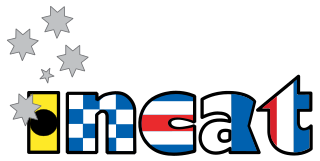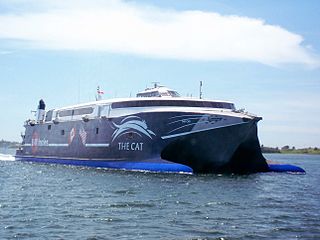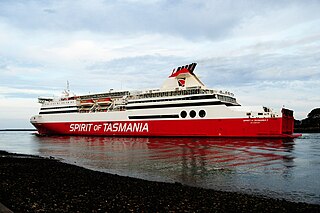
Bass Strait is a strait separating the island of Tasmania from the Australian mainland, and also providing the most direct waterway between the Great Australian Bight and the Tasman Sea. Formed 8,000 years ago by rising sea levels, the strait was named after English explorer and physician George Bass.

Devonport is a city in northern Tasmania, Australia, located on the lands of the Pirinilaplu clan of the Palawa nation. It is situated at the mouth of the Mersey River. Devonport had an urban population of 23,046 at the 2016 Australian census. When counting the larger urban area, including Latrobe, the population total was 30,297 at June 2018. The area has grown at an average annual rate of 0.17% year-on-year over the preceding five years.

The history of Tasmania begins at the end of the most recent ice age when it is believed that the island was joined to the Australian mainland. Little is known of the human history of the island until the British colonisation in the 19th century.

MS Theofilos is a passenger/vehicle ferry built at the Nobiskrug shipyard in Rendsburg, Germany in 1975.

Incat Tasmania is a manufacturer of high-speed craft (HSC) catamaran ferries. Its greatest success has been with large, sea going passenger and vehicle ferries, but it has also built military transports and since 2015 it has built smaller river and bay ferries. Based in Derwent Park, a suburb of Hobart, Tasmania, Australia, it was founded by Bob Clifford.

Huddart Parker Ltd was an Australian shipping company trading in various forms between 1876 and 1961. It was one of the seven major coastal shippers in Australia at a time when shipping was the principal means of interstate and trans-Tasman transport. The company started in Geelong, but in 1890 shifted its offices to Melbourne. By 1910 Huddart Parker had grown to rank 24th of the top 100 companies in Australia by asset value. Several of the company's ships served in World War I and World War II. Huddart Parker ceased to be an independent company in 1961, when it was taken over by Bitumen and Oil Refineries Australia Limited.

HMAS Jervis Bay was a wave piercing catamaran that operated in the Royal Australian Navy (RAN).

HSC INCAT 046 is a wave-piercing catamaran passenger-vehicle ferry. It has operated under various marketing names, including Devil Cat, The Cat, The Lynx, and now The T&T Express.

MS Princess Seaways is a cruiseferry operated and owned by the Danish shipping company DFDS Seaways on a route connecting North Shields, England, to IJmuiden in the Netherlands. She was built in 1986 as Peter Pan by Seebeckwerft, Bremerhaven, Germany for TT-Line. Between 1993 and 2002, the ship was operated by TT-Line Company of Tasmania under the name Spirit of Tasmania a service across the Bass Strait. In 2002, the ship was sold to Fjord Line and renamed Fjord Norway for service from Denmark. In 2006, she was sold to DFDS Seaways and sailed as Princess of Norway before being given her current name in 2011.

Hai Xia Hao is a passenger / vehicle ferry operated by Fujian Cross Strait Ferry between Taichung and Pingtan Island. The vessel is a high speed catamaran built by the Tasmanian shipbuilder Incat.

Australian National Line (ANL) was a coastal shipping line established in by the Government of Australia in 1956. It was sold in 1998 to CMA CGM.
Robert "Bob" Frederick Clifford AO,, and now living in Surrey, England, is an Australian shipbuilder, entrepreneur, and businessman, best known for his success in building his Incat catamaran building company into an international brand that sells wave piercing catamaran ferries all over the world including to the US military and many European ferry operators.

The HSC Condor 10 is a 74m fast catamaran ferry formerly that has operated in England, New Zealand, Australia and South Korea.

Mega Express Four is a fast roll-on/roll-off ferry owned by Corsica Ferries - Sardinia Ferries and operated on their routes from Nice and Toulon to Ile Rousse. She was built in 1995 by Schichau Seebeckwerft in Bremerhaven, Germany for Superfast Ferries as Superfast II. Between 2003 and 2006 she sailed for TT-Line as Spirit of Tasmania III.

MS Spirit of Tasmania I is a roll-on/roll-off ferry operated by TT-Line between Melbourne and Devonport in Australia. Built in 1998 by Kvaerner Masa-Yards at Turku New Shipyard in Finland for Superfast Ferries as MS Superfast IV, since 2002 she has sailed for TT-Line as MS Spirit of Tasmania I.

MS Spirit of Tasmania II is a roll-on/roll-off ferry operated by TT-Line between Melbourne and Devonport in Australia. Built in 1998 by Kvaerner Masa-Yards at Turku New Shipyard in Finland for Superfast Ferries as MS Superfast III, since 2002 she has sailed for TT-Line as MS Spirit of Tasmania II.

Bass Strait Ferries have been the ships that have been used for regular transport across Bass Strait between Tasmania and Victoria in mainland Australia, as well as the various attempts to link Tasmania with Sydney. Historically, some regular shipping services in the twentieth century linked Sydney, Melbourne and Hobart with the Bass Strait ports: Launceston's various port locations, Devonport and Burnie. The distinction between coastal shipping and Bass Strait ferry has been blurred at times.

HSC Sea Speed Jet is a high speed catamaran ferry built by Incat for Sea Containers in 1990. It has been owned by Sea and Sun Maritime Co. since 2014. The vessel is currently operated by Seajets.

Richardson Devine Marine is an Australian company, situated in Tasmania on Hobart's Derwent River. Hobart is the capital of Australia's island state.






















